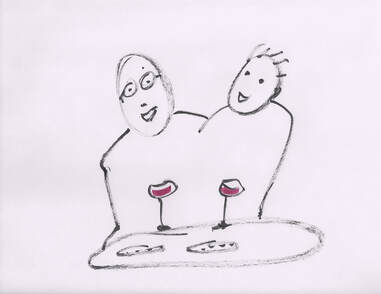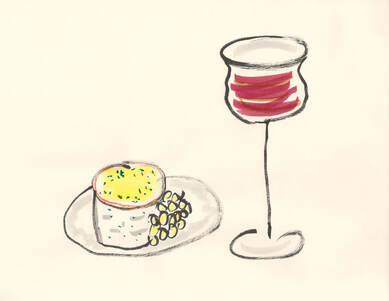 Your food and wines gain body and strength in lockstep with the conversation. Your food and wines gain body and strength in lockstep with the conversation. Choosing the right wine to go with your dinner is easy when you use these tips. However, food and wine pairing is more than just following tried-and-true rules created by chefs and sommeliers. Pairings provide you with an opportunity to get creative and treat your guests to a special evening, even if it is just a casual get-together. Think about it: as you plan the dinner, are you more concerned with orchestrating a great experience or with making technically correct wine choices? For most people, connecting with friends is at the top of the list. So relax when choosing your wines, this is not a contest. You can always open a different bottle if your initial choice does not hit the spot. The master plan is to pair your wine not only with the cuisine but with the ebb and flow of social interaction. Tell me, what usually happens when you have a couple over for dinner? When they knock on the door, do you invite them in and start with small talk? Maybe you ask about their day or you compare notes on how your favorite sports teams are performing. How might that equate with the wine you are serving? Perhaps you will pour a sparkling wine, such as a Prosecco, something low in alcohol and light and frothy, like the conversation. When you sit down to dinner, after you and your guests have loosened up a bit, you move on to a first course, such as a summer soup or a salad, and serve a white wine or rosé. As the courses progress, you find yourselves in conversation that has graduated to deeper, more meaningful topics. Your food and wines, too, can gain in body and strength in lockstep with the meal and dialogue. The idea is to pour your wine in progression with the overall experience of the diners. Start with light-bodied wines and graduate to heavier wines. Pour low-alcohol wines first, then amp up the experience with higher alcohol wines to match the heavier courses. Now that we are armed with the big picture, let’s get to the food and wine pairing tips, as promised. Choose wines that match the origin of the food. When I am asked to recommend a wine to go with a particular dish, my first inclination is to consider the origin of what is on the plate. In other words, is the dish associated with the cuisine of a particular country or region? If so, I take a mental trip to that location and consider the local wines on offer. For instance, if you plan to serve a pasta with red sauce, go right to Italy for the wine, perhaps selecting a Chianti Classico or a Brunello di Montalcino. When serving old-school American hamburgers from the grill, why not reach for a Zinfandel from California’s Sierra Foothills. You might instead elect to put some bratwurst on the grill and couch the sausages in soft buttery buns. In that case, you could go for a semi-sweet Riesling from the Pfalz, Germany’s second-largest wine region. You get the idea: eat and drink like a local. Match the intensity of the wine with that of the food. You probably have a pretty good feel for the intensity of the dish you plan to serve. For instance, you know that salads and seafood are generally less intense than barbecue ribs and ribeye steaks. When we talk about the intensity of a dish, we are usually thinking about the amount of fat and/or the boldness of the flavor. Salads and seafood are typically light in fat and delicate in flavor. These types of dishes call for wines with a light body and subtle flavors. Light bodied wines typically are low in alcohol, less than thirteen percent alcohol by volume. Wines to consider with light fare include Pinot Grigio, Prosecco and Vinho Verde. The ribs, with their bold barbecue sauce, and the ribeye steaks, with their juicy fat, call for wines that are equally bold in flavor and body. While proteins abound in main meals, it is often the sauce you put on them that will be the pointer to selecting wines with complementary flavors and intensity. For your ribs, the highly intense barbecue sauce will point you to a bold Zinfandel, Syrah/Shiraz, or Malbec as all these wines have strong flavor profiles and are full-bodied. Full-bodied wines present at around fourteen percent ABV or higher. The fats in your ribeye steak are responsible for delivering the juicy tenderness you crave. These same fats soften the tannins in wine and elevate tastiness, so look for red wines with medium to high tannins to go with those fatty red meat dishes such as Cabernet Sauvignon, Nebbiolo and Sangiovese. Match the key flavors of the food and the wine. We were talking about a red pasta sauce a moment ago. Some wines, such as Merlot, Cabernet Sauvignon and Carménère can exude the herbaceous aromas of tomato leaf, so you would be spot on to call on these wines to unlock the flavors of the tomato sauce in your mouth. Salads and other foods with citrus dressings or sauces offer a clear invitation to match wines with aromas and tastes of lemons or limes such as Sauvignon Blanc or a Vermentino or an Albariño. If you are serving cranberry sauce on your Thanksgiving turkey, Pinot Noir from Oregon, with its vibrant acidity and cranberry aromas, is a classic match. For a dessert that is dotted with kiwi fruit, a Chenin Blanc from Saumur in the Loire Valley of France might offer up a similar aroma. If you cook up a beef stroganoff with mushrooms, your nose may catch mushroom aromas from mature Pinot Noirs, Nebbiolo wines, or Spanish Rioja wines.  Port wine envelops Stilton cheese in a bath of blackberry and chocolate flavors. Port wine envelops Stilton cheese in a bath of blackberry and chocolate flavors. Layer the experience with contrasting flavors. Contrasting but complementary flavors in your food and wine create entirely new taste sensations. An example of this is to pair fish and chips with a fresh and lively white wine. In this case, I might reach for a Verdicchio from Italy’s Marche region. Not only is this wine considered one of Italy’s best whites, it has the lively acidity to cut through the grease of what’s on the plate, refreshing your mouth for the next bite. If you are serving a salty Stilton cheese, a classic and satisfying contrast is a weighty, sweet Port wine. The Port’s body will envelop the semi-soft Stilton in a luxurious bath of blackberry and chocolate flavors. The two together are a perfect marriage of sweet and salty flavors. Is your mouth watering yet? Another sweet and salty pairing would start with crispy udon noodles with nori salt on the plate. The answer: Champagne’s sparkling wine to complement the salty fare with its light kiss of sweetness. Take the acidity of the food into account. Meals that sing with bright acidity are a natural companion to light, refreshing wines that are also high in acidity or tartness. Examples of foods with zesty acidity go beyond salads or whitefish topped with a squeeze of lemon. Balsamic chicken, any meal with pickled veggies, potato salads, balsamic glazed lamb, and food topped with chutney are all acidic in nature. When we talk about a wine’s acidity, we are describing that tart, sour taste you get in your mouth, like you would get from adding a twist of lime to your Mezcal or to a taco before you pop it into your mouth. Your first thought might be light-bodied, tart white wines such as Sauvignon Blanc, Vermentino or Albariño. However, exciting acidity can also be found in rosés from the Provence wine region of France, Pinot Noirs, Champagne and other sparkling wines, Beaujolais wines, and many others.  You want light-bodied, fresh and crisp wines to tame the spice. You want light-bodied, fresh and crisp wines to tame the spice. Take a special approach to pairing wine with spicy foods. There are a couple of ways to deal with spicy food when it comes to wine: either choose wines that complement the flavors of your spicy dish, or tame the heat with some sweetness and/or fruitiness. If you have a peppery dish, you can count on a juicy Shiraz blend from Australia to provide pepper notes while washing over the spices with jammy goodness. In this pairing, you are both complementing the peppery flavors and taming the heat with fruitiness. Another wine that could offer a fruity blanket over the spices in your dish would be a Beaujolais from just south of the Burgundy region of France. In general, you want light-bodied, fresh and crisp red or white wines to tame the spice. We are talking Pinot Grigio, Albariño, Riesling, a New Zealand Pinot Noir, and Sauvignon Blanc. Slightly sweet wines, such as off-dry Rieslings and Gewürztraminers, offer a pleasing contrast and provide a balance to the spice. Avoid wines that are high in alcohol or risk making your hot, spicy food taste even hotter. When cooking up a spicy dinner, I typically reach for a bottle with about twelve percent alcohol by volume. Pair desserts with sweet wines. Asti is a sweet sparkling wine from Italy that dances beautifully on the tongue with custards and other creamy desserts, scrubbing away the buttery fat with refreshing bubbles while going toe-to-toe on sweetness. A late-harvest Gewürztraminer is delicious with cinnamon-infused apple pies, both sharing not only the element of sweetness but also spiciness. For rich dark chocolate desserts, Port wine is a classic match. But you don’t have to stop there. Zinfandel, Syrah/Shiraz, and Sherry are willing mates for chocolate. Milk chocolate lovers might reach for Merlot or a Pinot Noir. A Cream Sherry might be just the ticket for a white chocolate dessert. Most high quality dessert wines are balanced by high acidity and taste quite fresh. These are not wines that will tire your palate with cloying sweetness. A quality sweet wine, such as an Icewine from Canada’s Niagara Peninsula or a Sauternes from France’s Bordeaux region, can be your dessert course, with or without food. In general, sweet wines are a natural match for spicy, salty, and sweet dishes. Remember, this is not rocket science. Don’t get too wrapped up in getting your pairings just right. We all make mistakes until we’ve practiced a bit. Like learning to ride a bicycle, matching the right wine with a plate of food feels a bit clumsy at first until you get the hang of it. Most of all, let your palate weigh in when you experience the food and wine together. Pairing food with wine boils down to matching the mood of the situation, the cuisine on offer, the company, the location, practical circumstances, budget, personal preferences, and so much more. You can paint your pairing situation with broad strokes, going with tried-and-true rules. You can go granular, matching your wine with the food’s country, wine region, cultural mores, and the mood of the get-together. Or you can fly high, with all your chips on the table, and experiment with food and wine combinations that nobody told you about. It is all good, and it is all part of your development as an aficionado of food and wine. This article is partially excerpted from my new book, Your Love Affair with Wine: How to Meet and Fall in Love with a Bottle of Wine, available on Amazon
0 Comments
Leave a Reply. |
AuthorLyne Noella Archives
October 2022
Categories
All
|


 RSS Feed
RSS Feed
